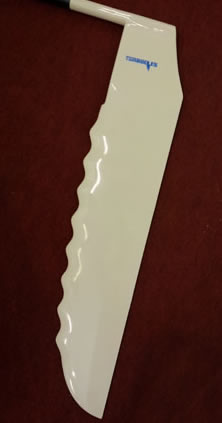Turbocoles rudder
 Hampshire based company 50° North SES Ltd have launched the revolutionary Turbocoles rudder at the Alexandra Palace Dinghy exhibition last weekend for Isle of Wight-based producers of high specification mouldings, Composite Craft.
Hampshire based company 50° North SES Ltd have launched the revolutionary Turbocoles rudder at the Alexandra Palace Dinghy exhibition last weekend for Isle of Wight-based producers of high specification mouldings, Composite Craft.
The Turbocles rudder is a not a new idea in yachts and larger craft but it is an almost unheard of concept in dinghies. But how?
Well, flippers on humpback whales have non-smooth leading edges (lumps called tubercules), yet have greater ‘grip’ to the traditionally smooth leading edges of rudders. Despite being 40-50 feet long humpbacks can swim in circles tight enough to produce nets of bubbles only five feet across!
This amazing ability is due primarily to its non-conventional flippers. Sheets of water flowing over smooth sections break up into turbulent vortices as they cross the rudder while sheets of water passing between the tubercules maintain even channels of fast-moving water allowing the rudder to keep “grip” on the water at sharper angles and providing the ability to turn tighter corners, even at low speeds.
Tests have demonstrated the fluid dynamic improvements tubercules make.
32% reduction in drag,
8% improvement in lift
40% increase in angle of attack over smooth sections before stalling
While the initial rudder has been made to fit the Hornet, Osprey, 505, Merlin, Hornet, Phantom and Scorpion other classes are coming soon. Prices are from £475 and, due to the flexible nature of our service, we can look into any alterations or further developments to suit other classes.
For further information email Toby Dawn Barsley-Dale here












Latest Comments
Ben_Howett 07/03/2012 - 21:37
Thanks JamesJames Boyd 07/03/2012 - 20:45
Toby Barsley-Dale from 50° North SES responds: I will have to go back to the designer for quantifiable data, but in a nut shell he is right, the advantage does come from reduced risk of stall. However this can be applied in two ways. Firstly, as in the case of the big boats prone to broaching, it has provided better performance from a rudder enabling the helmsman to maintain control. This can also be the case in dinghies which are known to be hard to control. One example has been fitted to an International Canoe and the owner said it resolved the control issues immediately. The other option is to use the extra grip provide by the design to reduce the section thickness of the foil and therefore end up with a foil with lower drag and enhance performance on all parts of the course. My own Hornet foil has been reduced from 23mm wide to 17mm. This could be taken slightly further on higher performance boats. I hope this helps in the short term.benjaminhowett@... 07/03/2012 - 13:13
At what speed and angle of attack are those drag and lift figures given? All the figures I’ve seen suggest that while tubercules may offer some improvements over conventional foils: these improvements only materialise at large angles of attack (ie close to stall) and performance in typical sailing conditions is reduced. There have been a few keelboats using this idea but by and large it has only been successful on boats prone to broaching and spinning out downwind – the extra control and safety factor makes up for the slight loss in performance in normal sailing. This article suggests that performance is actually increased around the course – are there figures to support this?Add a comment - Members log in